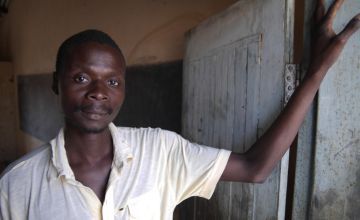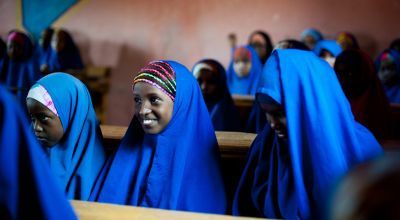
Read our 2023 annual report

Knowledge Hub
For girls, child marriage (aka forced or early marriage) means the end of an education. Here's how a landmark ruling in Malawi is helping to keep girls in school.
Daliyesi was a 14-year-old student from Dinyero village in southern Malawi. When her parents committed her to marry a 19-year-old from a nearby village, her school’s “fathers’ group” stepped in.
The group first approached the parents of both teenagers. When they couldn’t change their minds, they went to the local authorities. They cited the Marriage, Divorce, and Family Relations Act which, at the time, was just seven months old.
A historic law to keep girls in the classroom
Malawi’s historic act was passed in 2015 and established 18 as the minimum age for marriage. In a country where 50% of girls were traditionally married by that time (and over 12% married by age 15), this was a major achievement. It also helped keep Daliyesi in school.
A literate generation will benefit the entire community.
Once the fathers’ group brought up the new act in Daliyesi’s case, police and child protection workers jumped into the fray. The parents of both teenagers were forced to call off the marriage. They were also fined two goats per family under local laws. Best of all, Daliyesi stayed in school, completed fifth grade and moved on to sixth.
“As a fathers’ group, we work to protect and rescue vulnerable children, especially girls, from harmful cultural practices including early or forced marriages,” said 34-year-old Lenason Dinyero, a farmer and chairman of the group. “We have had some success and we are working hard on it. A literate generation will benefit the entire community.”
Child marriage and education
Being a girl is one of the strongest barriers to education around the world. It’s not entirely clear whether young girls drop out of school because they get married, or if they get married because they’ve dropped out of school. Either way, child marriage (also referred to as early marriage or forced marriage) is usually the end of a girl’s educational attainment.
Being a wife and mother becomes her new full-time job, and often leaves little time for the classroom. In some countries, having a child means that the mother legally cannot return to school.
Girls who don’t attend school to begin with are also more likely to be married young. According to Girls Not Brides, girls with no education are three times more likely to marry by the time they reach 18 compared to girls with secondary education (or higher). UNICEF estimates that approximately 650 million girls and women alive today were married before their 18th birthday. This is considered a form of gender-based violence (GBV), not only because these girls are underage, but also because early marriage leaves them susceptible to sexual and physical assault.
Fighting gender-based violence with education
Malawi ranks 171 out of 189 countries on the Gender Development Index. One of the key criteria for the United Nations Development Programme in this ranking is knowledge and education. A 2014 Human Rights Watch report noted that girls who married early reported facing difficulties in finding school fees and accessing flexible school programs.
On average, most girls in Malawi receive only three years of education. The Marriage Act, while important to addressing gender inequality, is one step in a long road to gender equality. Education is at the heart of much of Concern’s work, and there’s more that can be done in schools and communities to reduce gender-based violence.
As part of a grant from the United Nations Trust Fund to end violence against women, Concern implemented a programme in Malawi’s Nsanje District between 2012 and 2015 that supported girls’ education and addressed gender issues.
Our three areas of focus are:
- Providing a safe learning environment for 12,000 girls in 17 primary schools across Nsanje
- Empowering stakeholders with a greater capacity to prevent and respond to gender-based violence, in both schools and wider communities
- Working with local and national authorities to strengthen the implementation of national commitments to address school-related GBV

Father’s groups step up the fight
Through this program, school authorities monitored girls’ attendance and instances of corporal punishment and harassment. Teachers and community leaders, including police and health officials, received training on child protection matters.
Communities established student councils at all 17 schools to serve as the voice of pupils and engage with school officials. Working with the group Theatre for a Change, the councils helped bring skits and games into the schools to address issues of GBV, positive discipline and child protection.
During this program, female attendance and retention rates in Nsanje schools increase. There was also a decline in violence and in the percentage of students and teachers who believed physical punishment was acceptable for disciplining learners.
Ending child marriage and GBV is a job for all genders. As such, male students, fathers, and community elders met to explore issues of masculinity and gender equality. These meetings resulted in the establishment of the fathers’ group that Dinyero chairs. Their work includes mediating situations like Daliyesi’s, or bringing in authorities when they can’t work out a solution. This is to ensure that girls have access to a safe learning environment.
Giving forced marriage a failing grade
Despite this success, it takes more than a few years to change behaviours, attitudes and norms on gender issues. Violence against both boys and girls in Nsanje remains pervasive, and girls continue to report considerable pressure to leave school early and get married.
One of the United Nations’ Sustainable Development Goals is to eliminate child marriage by 2030. Child marriage rates have decreased by 15% over the last 10 years (which means 25 million child marriages have been prevented in that time). However, no region is on track to meet this goal in the next 10 years.
According to UNICEF, the Middle East and North Africa saw substantial progress to reducing the prevalence of child marriage over the past 25 years. But progress has slowed in the last 10 years. In Latin America and the Caribbean, the rate of early marriage remains unchanged. Girls from vulnerable communities remain at risk of forced marriage. South Asia is home to the largest number of child brides (285 million), followed by sub-Saharan Africa (115 million).
Years of advocacy help laws like the Marriage Act in Malawi become a reality. But, as we’ve seen with Daliyesi’s case, change requires more than an act being signed into law. The success of keeping girls in front of the blackboard rather than on a bridal altar lies in the courage to enforce these provisions at a community level.




